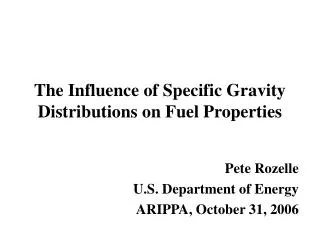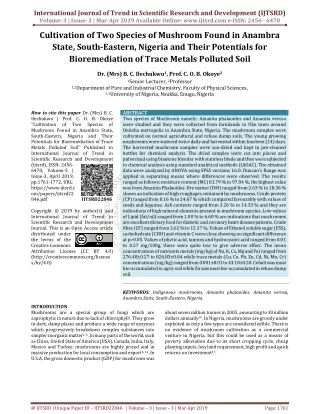Cultivation of Two Species of Mushroom Found in Anambra State, South Eastern, Nigeria and Their Potentials for Bioremedi
Two species of Mushroom namely Amanita phalaoides and Amanita verosa were studied and they were collected from farmlands in Uke town around Onitsha metropolis in Anambra State, Nigeria. The mushroom samples were cultivated on normal agricultural and refuse dump soils. The young growing mushrooms were watered twice daily and harvested within fourteen 14 days. The harvested mushroom samples were sun dried and kept in pre cleaned bottles for chemical analysis. The dried samples were cut into pieces and pulverized using binatone blender with stainless blade and they were subjected to chemical analysis using standard analytical methods AOAC . The obtained data were analyzed by ANOVA using SPSS versions 16.0. Duncan's Range was applied in separating means where differences were observed. The results ranged as follows moisture content MC 81.79 to 97.84 , the highest value was from Amanita Phalaoides. Dry matter DM ranged from 2.63 to 18.36 shows an indication of high roughages contained by mushrooms. Crude protein CP ranged from 8.16 to 24.67 which compared favourably with values of seeds and legumes. Ash contents ranged from 3.26 to 14.33 and they are indications of high mineral elements present in mushroom species. Low values of Lipid fat oil ranged from 1.00 to 6.68 are indications that mushrooms are excellent dietary food for diabetic and coronary heart disease patients. Crude fibre CF ranged from 2.62 to 15.37 . Values of Ethanol soluble sugar ESS , carbohydrate CHO and vitamin C were close showing no significant difference at p 0.05. Values of phytic acid, tannins and hydrocyanic acid ranged from 0.01 to 0.27 mg 100g, these were quite low to give adverse effect. The mean concentrations of nutrients metals mg kg of Na, K, Ca, Mg and Fe ranged from 276.48u00c2u00b10.27 to 826.83u00c2u00b10.04 while trace metals Cu, Co, Pb, Zn, Cd, Ni, Mn, Cr concentrations mg kg ranged from 0.001u00c2u00b10.01 to 43.18u00c2u00b10.20. Cobalt was most bio accumulated in agric soil while Zn was most bio accumulated in refuse dump soil. Dr. (Mrs) B. C. Ilechukwu | Prof. C. O. B. Okoye "Cultivation of Two Species of Mushroom Found in Anambra State, South-Eastern, Nigeria and Their Potentials for Bioremediation of Trace Metals Polluted Soil" Published in International Journal of Trend in Scientific Research and Development (ijtsrd), ISSN: 2456-6470, Volume-3 | Issue-3 , April 2019, URL: https://www.ijtsrd.com/papers/ijtsrd22846.pdf Paper URL: https://www.ijtsrd.com/biological-science/cell-biology/22846/cultivation-of-two-species-of-mushroom-found-in-anambra-state-south-eastern-nigeria-and-their-potentials-for-bioremediation-of-trace-metals-polluted-soil/dr-mrs-b-c-ilechukwu
★
★
★
★
★
143 views • 12 slides

